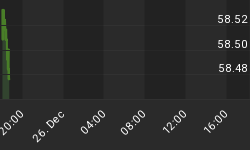I wonder how many times the Fed needs to be more dovish than expected before investors realize that this is a dovish Fed?
It may indeed be the most dovish Fed ever, judging from Dr. Yellen's prior statements and history. And yet, investors seemed to have convinced themselves that with core inflation measured in the Fed's preferred way far below its target (to be sure, it's not the right way to measure it, but they're not looking for excuses to hike), with structural unemployment still high (see chart of "Not in Labor Force, Want a Job Now," source Bloomberg, below), with other central banks aggressively easing so that our dollar is aggressively strengthening, and with recent economic indicators surprising on the low side at the most-rapid pace since 2011, the Fed was going to put itself on a track to start hiking rates by early summer.

In the event, the Fed told us that they are no longer going to be automatically "patient" - which was the word that 90% of economists expected them to remove from the statement - but the Committee's median projections for the year-end Fed funds rate dropped 50bps since the last meeting, to just above 0.5%.
Why won't investors listen? It isn't as if the last Fed Chairman was a renowned hawk. It's been a generation since we had a real hawk in the Chairman's seat. So I have no idea why it is a shock to people that the Fed acts dovishly, even as Chairman Yellen says the Fed will need to "monitor inflation developments carefully."
If they were monitoring inflation developments carefully, they would know that median inflation is already at levels that represent achievement of the Fed's target. If they were monitoring inflation developments carefully, then they would know that the dollar (which Yellen says will keep inflation lower for longer) has very little impact on domestic pricing, outside of goods that are largely produced overseas (apparel) or certain raw commodities (like energies).
Or, perhaps, just perhaps...they actually do know these things, but prefer to rely on obfuscation to keep rates as low as they can for as long as they can, until the market absolutely demands that they raise them. With market interest rates low, and the dollar strong, there is absolutely no market pressure for the FOMC to raise rates. Therefore, they will not.
At this writing, 10-year breakevens are +11bps on the day. Over the last week or two, after a mild bounce from the beaten-down lows, fast money had been leaning on breakevens again and pushing them inexorably lower. How do I know it was fast money? Because 10-year breakevens are up 11bps in a freaking hour, after a mild adjustment in the "dots." That isn't the sort of move that reflects long-term planning.
I continue to be flabbergasted at how the Fed maintains its credibility. We all know that the Fed has been considerably worse than the average economic forecaster over a long period of time. But it even seems to have trouble with current data. On the tape right now, the Chairman is saying that the "residual effects" of the financial crisis are restraining credit. Really? The chart below shows commercial bank credit. Does that look restrained to you? It is rising at better than an 8% pace y/y, the fastest level since May 2008. And it's 10%-11% annualized on a q/q basis.

Sometimes I want to echo that commercial for Esurance. "That's not how it works. That's not how any of this works."
When market rates go higher, and/or the dollar weakens because our domestic inflation starts being appreciably more than that of our trading partners, then the Fed will get serious about tightening. But it will have to be serious enough to handle the downward adjustment in securities prices that will happen when they begin to do so. I can't foresee a time when that's particularly likely. The Fed eschewed tightening over the last few years with an economy that had good momentum (see the first chart above). How likely is it that the Fed will get ambitious about hiking rates in the late stages of an expansion that is long in the tooth? With this Chairman? I wouldn't hold your breath.
You can follow me @inflation_guy!
Enduring Investments is a registered investment adviser that specializes in solving inflation-related problems. Fill out the contact form at http://www.EnduringInvestments.com/contact and we will send you our latest Quarterly Inflation Outlook. And if you make sure to put your physical mailing address in the "comment" section of the contact form, we will also send you a copy of Michael Ashton's book "Maestro, My Ass!"
















